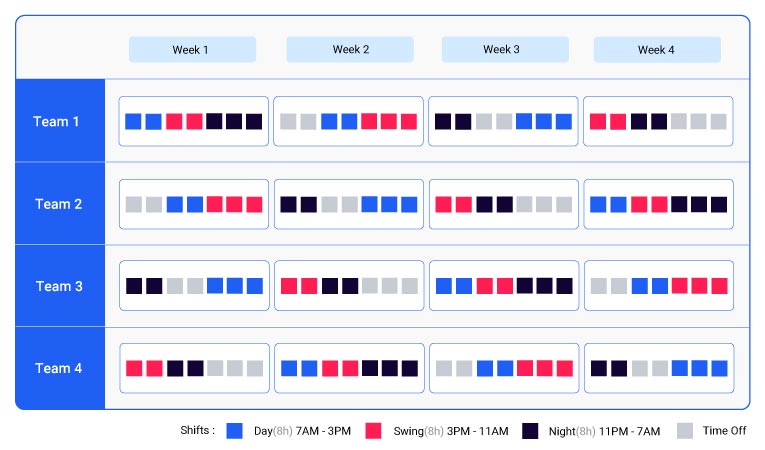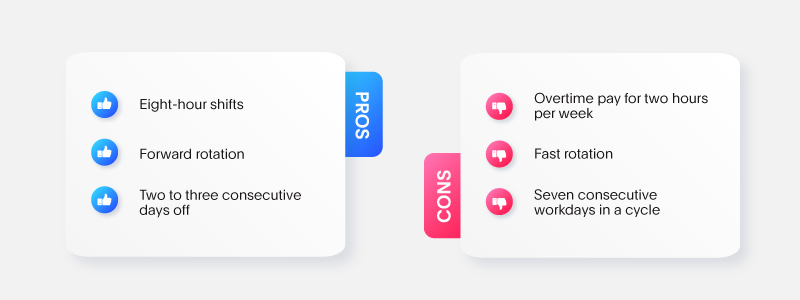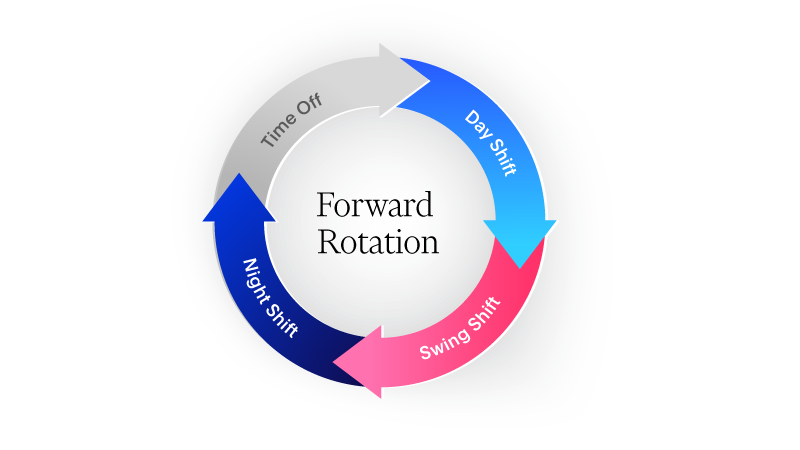What Is a Continental Shift Pattern and How to Implement It?

Most rotating schedules involve two 12-hour shifts to provide 24-hour coverage to critical business operations. But, working 12-hour shifts can be too tiring for employees and disturb their work-life balance.
So, what’s the alternative?
The answer is a Continental Shift Pattern – a forward rotation schedule with short-duration shifts that works well for many industries.
So, in this blog, we’ll touch upon the work pattern of continental shift, its pros & cons, and tips to implement this schedule successfully.
What Is a Continental Shift Pattern?
The continental shift pattern is a fast-rotating schedule with a 28-day repeat cycle in which four teams work together to provide 24-hour coverage. This schedule requires three 8-hour shifts – day, swing, and night shifts every day to operate.
Here, each team goes through a sequence of 2 to 3 consecutive day shifts, swing shifts, night shifts, and days off in the 28-day repeat cycle.
The entire cycle is divided into four-week patterns, and all teams go through each week to complete the cycle. Here’s a typical schedule for a 4-week repeat cycle:
|
Week 1 |
2-day shifts |
2-swing shifts |
3-night shifts |
|
Week 2 |
2-days off |
2-day shifts |
3-swing shifts |
|
Week 3 |
2-night shifts |
2-days off |
3-day shifts |
|
Week 4 |
2-swing shifts |
2-night shifts |
3-days off |
However, not all teams start their shift from week 1. For example, if there are four teams named A, B, C, and D, then Team A starts from week 1, Team B will start from week 2, Team C will start from week 3, and Team D will start from week 4.
|
The Continental Shift pattern at a glance:
|
Here’s a Demonstrative Diagram to Help You Understand How This Shift Works

In this work pattern, after every seven consecutive work blocks, each team gets two to three days off to relax and recharge.
Let’s look closely at the work pattern of four teams for week 1:
If there are four teams, i.e., Team 1, Team 2, Team 3, and Team 4, that work in the continental schedule to provide 24-hour coverage, here’s how they’ll work:
- Day 1 and Day 2: Team 1 will work the day shifts, Team 4 will work the swing shifts, and Team 3 will work the night shifts. On the other hand, Team 2 will be on time off for these two days.
- Day 3 and Day 4: Team 1 will work the swing shifts, Team 2 will work the day shifts, and Team 4 will work the night shifts. While Team 3 will be on time off.
- Day 5, Day 6, and Day 7: Team 1 will work the night shifts, Team 2 will work the swing shifts, and Team 3 will work the day shifts. During these three days, Team 4 will be on time off.
This way, a business can operate around the clock as someone will always be there to cover the work operation.
For instance, if a hospital requires healthcare workers day in and day out to look after the patients, then the staff can be divided into four groups operating on three different shifts:
- 5 am to 1 pm (morning shift)
- 1 pm to 9 pm (swing shift)
- 9 pm to 5 am (night shift)
All teams can rotate through the sequence of different shifts to attend to patients 24/7.
Pros and Cons of Continental Shift Pattern

Advantages of Continental Shift
-
Shorter, Less Hectic Shifts
Most rotational schedules use two 12-hour shifts to provide 24-hour coverage; however, these longer-duration shifts are taxing. What sets the continental shift pattern apart is its 8-hour shifts that aren’t as hectic as the conventional 12-hour ones.
The shift pattern leverages three shifts instead of two, i.e., day, swing, and night shifts of 8 hours, adding up to 24 hours of the day. The short-duration shifts minimize the chances of burnout in employees and improve their work-life balance.
-
Around-the-Clock Services
Continental shift allows businesses such as restaurants, hospitals, and call centers to provide services 24/7. This schedule uses three shifts for around-the-clock operation; this way, someone will always attend to the customers at any time of the day.
Besides, this 24/7 work culture removes the barrier of time zone differences, thus helping businesses attract global customers.
-
Predictability and Better Work-Life Balance
This schedule is predictable, and workers can easily estimate their upcoming shifts, such as which week has more time off and which one is busier.
Once they know their timetable, it’s easier to plan things accordingly, such as going for a short trip, booking an appointment, visiting the bank, or completing some pending errands.

-
Forward Rotation for Better Health
The continental schedule involves forward rotation, which has an advantage over the schedules with backward rotation. Here, the shift rotates from day shift to swing shift and from swing to night shift, thus delaying the phase of the body clock.
Research has found that forward rotation is less harmful than backward rotation. Forward rotation results in fewer physical problems, reduced fatigue, and better sleep quality. In fact, workers who have worked in both rotations find the forward rotation more favorable.

-
Fewer Conflicts With Fair Distribution of Shifts
In a continental shift pattern, everyone gets their fair share of shift type; i.e., this schedule distributes the night, day, and swing shifts equally among all teams.
Thus, each team gets the same number of favorable and unfavorable shifts, which reduces the chances of conflicts among employees.
Disadvantages of Continental Shift
Tiring Week With Continuous Seven Shifts
During the first week of the cycle, a team has to work all seven days but in different shifts. Seven shifts in a row can take a toll on an employee’s mental & physical health, leading to dissatisfaction and poor work-life balance.
Required to Pay Overtime
Though the schedule consists of 8-hour shifts, each employee will have to do an average of two hours of overtime per week. Thus, employers will be required to pay overtime to the employees for extra hours worked each week as per the local labor laws to stay compliant.
For this and to keep track of each employee’s overtime hours, employers can leverage any efficient time-tracking software that accurately captures employees’ work hours and calculates overtime pay as per that region’s prevailing laws.
Disturbed Body Clock Due to Fast Rotating Shift
Rotating shift work is associated with a disrupted circadian rhythm, which can have dire consequences in the form of sleep disorders, cardiovascular issues, and gastrointestinal problems. On top of that, the continental shift involves a fast rotation cycle (rapid changes in the shifts), which can further aggravate the situation.
Moreover, this schedule works with three different shift timings to cover 24 hours. Thus, working different shifts each day can have an adverse effect on employees’ daily routines, sleep cycles, and body clocks, especially if they don’t pay attention to their health.
Difficulty in Finding Childcare Services
The continental schedule involves three shifts; thus, employees need to work at different times each day. This situation can be problematic for parents with young kids, who may find it difficult to get childcare facilities for their children at odd hours.
Negative Impact on Relationships with Friends and Family
Individuals working this shift pattern don’t get enough time to spend with their families on a daily basis due to the constantly changing shifts. For instance, if a family has a routine to meet every day over dinner, it wouldn’t be possible for these shift workers to be available as per that due to fluctuating shift timings. Thus, workers of this shift are more prone to experience isolation, disturbed relationships, and loneliness.
Implementing the Continental Shift Pattern: Challenges Employers Face
As with any shift, implementing something new isn’t easy and requires some measures. Let’s have a look at these to understand how to deal with the challenges.
1. Manually Setting Shifts
Creating roster shifts manually for four teams takes a lot of effort and time.
- Solution: Employers can leverage any efficient scheduling software to create conflict-free shifts and keep employees informed about their upcoming shift cycle.
2. Tracking Attendance and Work Hours
Another challenge for employers is keeping track of employee attendance, days off, and work hours during each cycle.
- Solution: Employers can leverage time tracking software, such as Replicon, which accurately tracks employees’ work hours and their time off in a hassle-free manner.
How to Implement the Continental Shift Pattern
To successfully put this shift pattern in place, employers need to make it easy for the workers in different ways. This starts with giving them adequate information wherever required, working on any possible roadblocks and providing the right work environment. Let’s explore these in detail.
Establish a System of Communication
Successfully implementing any work schedule requires a well-defined system for effective communication. So, before embarking on this schedule, consider taking your employees’ and managers’ opinions and views. This will help you ascertain the challenges that may appear down the road.
Also, effective communication is beneficial when some employees want to swap their shifts with their colleagues.
For example, young parents may prefer to work day shifts more as it allows them to spend some time with their children during the night. On the other hand, working students may choose to take up the evening shifts after their school hours.
Thus, an effective communication system can serve as a bridge between workers, managers, and employers, allowing them to swap their shifts while keeping their respective managers/supervisors informed.
Create a Schedule in Advance
When you create a schedule in advance, it becomes easier for employees to arrange their personal commitments while keeping their work obligations in mind.
So, it’s a good practice to inform your employees about their shifts in the next cycle ahead of time. This way, your staff would know what’s expected from them, including what shift they have to work, when, and for how long, and more.
When employees have better control over their time this way, they feel motivated and productive at work.
Tip: Creating a staff roster is tedious and requires meticulous planning and analysis. As a solution, you can leverage any efficient scheduling software, such as Replicon’s Workforce Management solution, to create conflict-free schedules.
Resolving the Lag Time Between Two Shifts
When the previous shift workers end their work, and the next shift employees arrive to continue the work operation, employers may experience some lag during this brief period. That’s because the next shift worker would need some time to punch in or perform some minor daily tasks before starting the work.
Though most jobs can find this lag time insignificant, some industries, such as manufacturing, which need a consistent workforce 24/7 can be affected by this lag time.
To tackle this issue, consider starting the next shift 10-20 minutes before the previous one ends. This way, you can give the next shift workers some buffer time to prepare themselves, such as punching in, wearing safety garments, checking mail, or reporting to the supervisor.
Thus, by starting a bit early, employees can join the work on time as their colleagues leave for the day, eliminating the lag time.
Creating Customized Schedules
Some businesses experience a busy period during certain parts of the day, while others face a surge of customers on a seasonal basis.
That’s why you should use a customizable schedule that can cater to your needs. You can leverage data analytics and resource management tools that help you stay abreast of the busy period of your business so that you don’t experience a staff shortage during any peak period.
Ensure Adequate Lighting in Office Space
During the nighttime, as it gets darker, our body releases the melatonin hormone that induces sleepiness. Thus, low lighting can cause drowsiness and inattentiveness in employees if they work late hours.
Since this schedule involves swing and night shifts, keeping offices well-lit using natural or artificial light is necessary to mitigate the effects of late working hours. Adequate lighting not only suppresses drowsiness but also stimulates alertness and concentration.
|
As per studies, it’s recommended to use lighting with an illuminance level of at least 1000 lux for night shift workers to foster alertness and concentration. |
In addition, you should ensure that the workspace has a proper ventilation system to provide an adequate supply of fresh air in the office.

Prioritize Self-Care and Personal Well-Being
When employees work odd shifts that change continuously, their body’s natural circadian rhythm will most likely suffer. This can lead to poor eating habits, sleep disorders, and unhealthy lifestyles.
So, as an employer and manager, you must place enough importance on your staff’s well-being. Consider conducting wellness programs from time to time to encourage employees to adopt a healthy lifestyle. You can educate them about the significance of exercise, sleep, and a balanced diet through such campaigns.
Have an Open Door Policy
When you implement this schedule in your organization for the first time, employees may face difficulty adjusting to this shift pattern. It’s suggested that you should cooperate with employees and help them transition with ease.
Consider regularly checking with the employees if they face any major issues or if you can do anything to facilitate their adaptation to this shift.
Also, consider introducing an open-door policy in your organization so that employees don’t hesitate to contact their managers for any concern, query, or issue.
Regularly Review the Shift Pattern
Business needs and workflow paradigms can change over time due to different reasons. Thus, make sure that the existing shift pattern is aligned with the business needs and remains just for all employees. In case you feel that the shift pattern is not fulfilling your major requirements, you can try experimenting with other schedules, such as 2-2-3 or DuPont Schedules that provide 24-hr coverage.
Which Industries Use the Continental Shift Schedule?
Organizations that require around-the-clock services but need short-duration shifts benefit from this shift pattern. Here are a few industries that can find this shift pattern suitable:
|
Should You Use a Continental Shift Pattern?
A continental shift pattern is most suitable for employers who need 24/7 operations with short-duration shifts.
But make sure you have the answers to these questions before implementing this shift pattern in your organization:
- Does your organization require 24/7 working?
- Do you have enough resources to split into four teams?
- Are your employees ready to work in this fast-rotating shift cycle?
- Are your employees ready to work three shifts (day, swing, and night) of 8 hours on different days?
- Are employees willing to work seven consecutive days in a row?
Have a brainstorming session with your managers and employees to explain how this schedule works and discuss the challenges that may arise after its implementation. Consider their opinions, as it’ll give you insight into the suitability of this shift.
You can also go for a short trial period to understand if this schedule fits your needs. You can first implement this shift pattern in one department for one cycle. This approach will allow you to understand the pros, cons, challenges, and the aptness of this schedule in your organization.
Note: If you don’t find this schedule suitable, you can look into a 2-2-3 work schedule, which also provides 24-hr coverage but uses two 12-hr shifts.
Bottom Line
Continental shift is a forward rotation shift pattern that involves three shifts, namely, day, swing, and night shifts of 8 hours. This shift ensures critical businesses can operate around the clock without interrupting customer services or business operations.
The four teams alternate between day, swing, and night shifts in a 28-day rotational cycle, and all teams get a fair share of favorable and less favorable shifts.
So, if you’re willing to implement this schedule, ensure that your employees are well-acquainted with its work paradigm and that you have a fail-safe tool to schedule shifts for your workers.






